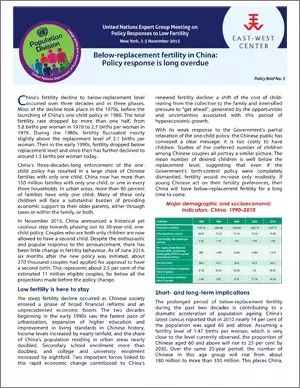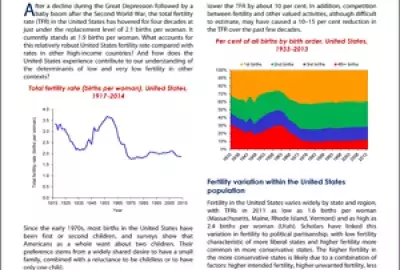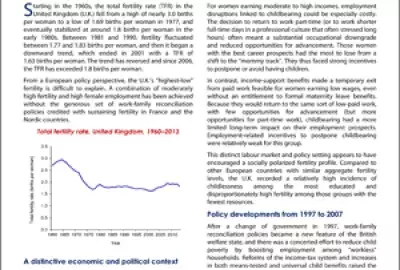Error message

China's fertility decline to below-replacement level occurred over three decades and in three phases. Most of the decline took place in the 1970s, before the launching of China's one-child policy in 1980. The total fertility rate dropped by more than one half, from 5.8 births per woman in 1970 to 2.7 births per woman in 1979. During the 1980s, fertility fluctuated mostly slightly above the replacement level of 2.1 births per woman. Then in the early 1990s, fertility dropped below replacement level and since then has further declined to around 1.5 births per woman today. China's three-decades-long enforcement of the one-child policy has resulted in a large share of Chinese families with only one child. China now has more than 150 million families with only one child, or one in every three households. In urban areas, more than 90 per cent of families have only one child. Many of these only children will face a substantial burden of providing economic support to their older parents, either through taxes or within the family, or both. In November 2013, China announced a historical yet cautious step towards phasing out its 30-year-old, one-child policy. Couples who are both only children are now allowed to have a second child. Despite the enthusiastic and popular response to the announcement, there has been little change in fertility behaviour. As of June 2014, six months after the new policy was initiated, about 270 thousand couples had applied for approval to have a second birth. This represents about 2.5 per cent of the estimated 11 million eligible couples, far below all the projections made before the policy change.
|
China's fertility decline to below-replacement level occurred over three decades and in three phases. Most of the decline took place in the 1970s, before the launching of China's one-child policy in 1980. The total fertility rate dropped by more than one half, from 5.8 births per woman in 1970 to 2.7 births per woman in 1979. During the 1980s, fertility fluctuated mostly slightly above the replacement level of 2.1 births per woman. Then in the early 1990s, fertility dropped below replacement level and since then has further declined to around 1.5 births per woman today. China's three-decades-long enforcement of the one-child policy has resulted in a large share of Chinese families with only one child. China now has more than 150 million families with only one child, or one in every three households. In urban areas, more than 90 per cent of families have only one child. Many of these only children will face a substantial burden of providing economic support to their older parents, either through taxes or within the family, or both. In November 2013, China announced a historical yet cautious step towards phasing out its 30-year-old, one-child policy. Couples who are both only children are now allowed to have a second child. Despite the enthusiastic and popular response to the announcement, there has been little change in fertility behaviour. As of June 2014, six months after the new policy was initiated, about 270 thousand couples had applied for approval to have a second birth. This represents about 2.5 per cent of the estimated 11 million eligible couples, far below all the projections made before the policy change.
|
Policy Briefs - United Nations Expert Group Meeting on Policy Responses to Low Fertility







